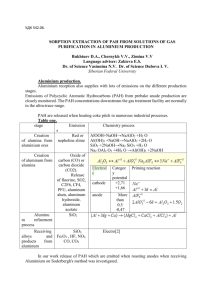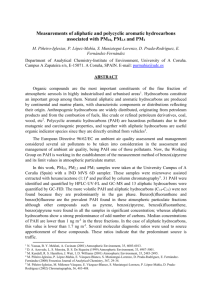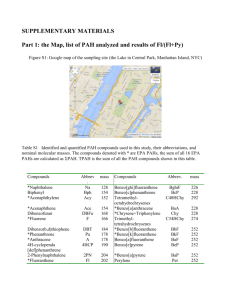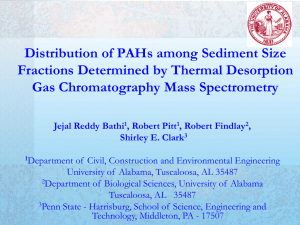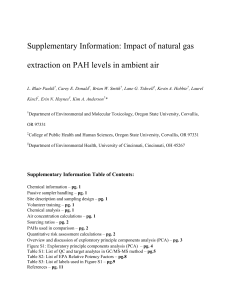On-roadway in-cabin exposure to particulate matter: measurement
advertisement
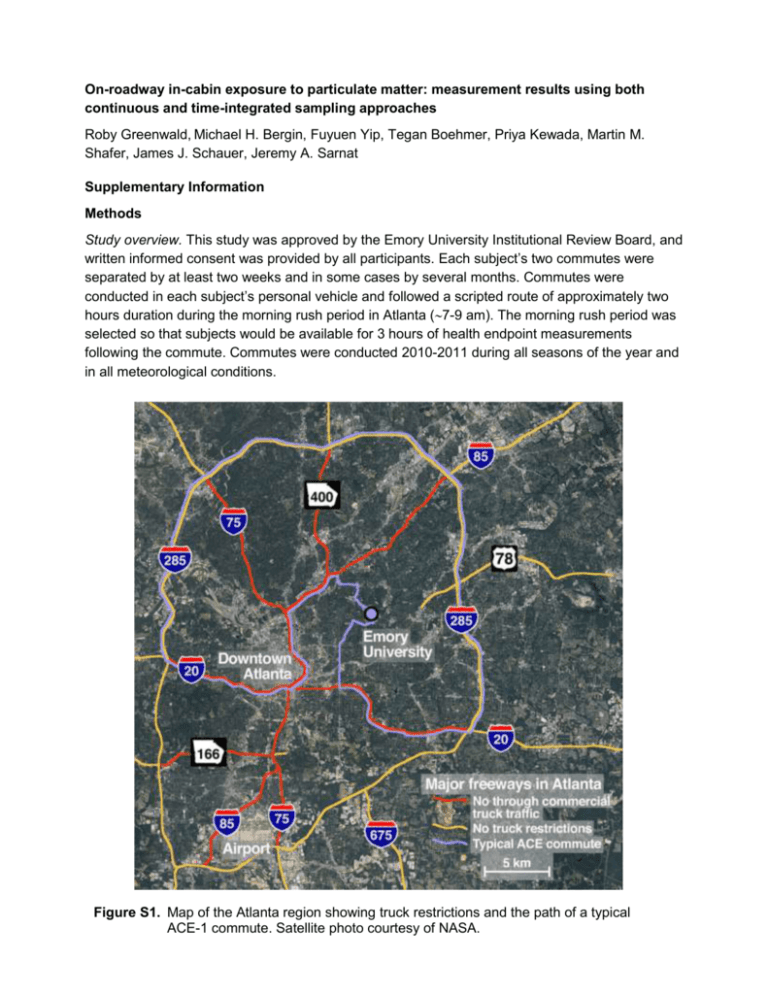
On-roadway in-cabin exposure to particulate matter: measurement results using both continuous and time-integrated sampling approaches Roby Greenwald, Michael H. Bergin, Fuyuen Yip, Tegan Boehmer, Priya Kewada, Martin M. Shafer, James J. Schauer, Jeremy A. Sarnat Supplementary Information Methods Study overview. This study was approved by the Emory University Institutional Review Board, and written informed consent was provided by all participants. Each subject’s two commutes were separated by at least two weeks and in some cases by several months. Commutes were conducted in each subject’s personal vehicle and followed a scripted route of approximately two hours duration during the morning rush period in Atlanta (7-9 am). The morning rush period was selected so that subjects would be available for 3 hours of health endpoint measurements following the commute. Commutes were conducted 2010-2011 during all seasons of the year and in all meteorological conditions. Figure S1. Map of the Atlanta region showing truck restrictions and the path of a typical ACE-1 commute. Satellite photo courtesy of NASA. With the exception of 1 subject, all commutes began and ended at Emory University, and subjects were accompanied by a field technician who sat in the back seat of the subject’s vehicle. For the subject that was the exception, pre-commute health measurements were performed at his residence, and the commute ended at Emory University. Commute routes were selected to emphasize the Atlanta Perimeter Highway, I-285, and to maximize the time spent on controlledaccess freeways (Figure S1). State regulation requires commercial traffic transiting Atlanta to use I-285 when not making local deliveries. Accordingly, diesel truck traffic is typically higher on I-285 (5500 total vehicles and 530 trucks per hour on weekdays 7-9 am) while total traffic is higher on I75/85 in downtown (8900 vehicles and 380 trucks per hour on weekdays 7-9 am, data from Georgia Department of Transportation public database for 2010-2011). Continuous measurements. All continuous instrumentation, filter holders, and cascade impactors were placed in a sampling tray located in the front passenger seat of the vehicle (Figure S2). A continuous estimate of the PM2.5 mass concentration was calculated using an optical particle counter (AeroTrak model 9306, TSI Inc.). This instrument includes 5 channels in the size range spanning 0.3-2.5 µm and a sixth for Dp>2.5 µm. Mass concentration was estimated by first converting the measured number concentration from the lower 5 channels to a volume concentration by assuming that particles are spherical with a diameter equal to the log-midpoint of the corresponding channel. For each commute, an estimate of particle density (referred to as “synthetic density”) was obtained by integrating the time-resolved calculations of particle volume and dividing by the measured mass from PM2.5 filters (method described below). The volume Figure S2. Schematic of instrumentation for ACE-1. This bin rests in the front passenger seat and filter flow is provided by vacuum pumps installed in the vehicle trunk. concentration was subsequently converted to a mass concentration by applying the synthetic density to each time-resolved measurement. The mean synthetic density for all commutes was calculated to be 1.9±1.2 g·cm-3. Two different instruments were used for measurements of PNC with the principal difference being the lower size limit of detection. The P-Trak (model 8525, TSI Inc.) counts all particles larger than 20 nm and was used for all commutes while a handheld condensation particle counter (CPC model 3007, TSI Inc.) counts all particles larger than 10 nm, but was acquired in the second half of the study. Black carbon (BC, MicroAeth AE51, AethLabs), particle-bound PAHs (pbPAHs, PAS 2000CE, EcoChem), and noise (HD600, Extech Instruments) were also measured with continuous devices. Integrated measurements. A 2-stage Harvard Compact Cascade Impactor (Demokritou et al. 2004) was operated at 30 L·min-1 to collect coarse and fine mode particulates for elemental analysis using a polyurethane foam (PUF) substrate on the coarse stage and a 47 mm polytetrafluoroethylene (PTFE) after-filter (SKC Inc.). In addition, fine particles were collected on 3 quartz fiber filters (SKC Inc.): a 47 mm filter for organic speciation operated at 30 L·min-1 and two 25 mm filters for elemental and organic carbon analysis operated at 15 L·min-1. Each filter holder was preceded by a 2.5 µm size cut inertial impactor. Filter samples were not denuded to remove gas-phase or semi-volatile components. The pumps were replaced with different models after 53 commutes, and there was not a significant difference in flow rate between the 2 sets of pumps; however, the coefficient of variation was higher for the replacement pumps (0.13 and 0.38 respectively). PM speciation. All analytical methods of PM speciation used for this study have been previously described in the literature. Fine PM elemental composition was measured at the University of Wisconsin (UWis) using inductively-coupled plasma-mass spectrometry analysis of cascade impactor after-filters (Lough et al. 2005). Organic speciation (including alkanes, hopanes, and PAHs) was also conducted at UWis using thermal desorption-mass spectrometry analysis of the 47 mm quartz fiber filters (Sheesley et al. 2007). The mass concentration of organic and elemental carbon (OC and EC) was measured independently at both UWis and Georgia Tech (GT) using thermal-optical transmittance analysis of a 1 cm2 punch from one of the 25 mm quartz fiber filters (Birch and Cary 1996). An aqueous extract of water-soluble PM components was prepared by immersing a 1 cm2 punch of a quartz fiber filter in 30 mL of ultrapure water and placing in an ultrasonic bath for 30 minutes. This aqueous extract was analyzed at GT to determine the content of water-soluble organic carbon (WSOC) (Hagler et al. 2007). Results and Discussion Study overview. A total of 81 commutes were completed with a mean±SD duration of 142±13 minutes. Three commutes (4% of the total) were canceled between enrollment and exposure date. In each case, this was the second commute for a subject; in 1 case, the subject declined to participate a second time and in 2 cases, the subjects relocated out of town before completing the protocol. The most common type of vehicle was sedan/hatchback (52 commutes), followed by SUV (22), minivan (2), station wagon (2) and pickup truck (3). Vehicle age ranged from less than a year to 16 years with a median age of 5 years. Seven commutes were conducted in a hybrid vehicle, and 2 in a diesel vehicle. Figure S3. Correlation of continuous and integrated measurements. In each case, the filterbased measurement is on the x-axis, and the continuous measurement is on the yaxis. The sum of PAHs is the sum of fluoranthene, pyrene, benzo[ghi]fluoranthene, benz[a]anthracene, benzo[b+k]fluoranthene, benzo[a]pyrene, benzo[e]pyrene, benzo[ghi]perylene, and coronene. Relationship between continuous and integrated measurements. There was modest correlation between continuously-measured BC (integrated over the commute period) and filter-based EC (Pearson’s r=0.72) (Figure S3(a)). The slope of the linear regression model was close to 1 (slope=1.1, p[H0:slope=1]=0.37) though the intercept was 2.8±0.41 µg·m-3. Figure S3(b) shows the regression of pbPAH with the sum of the filter-based concentrations of fluoranthene, pyrene, benzo[ghi]fluoranthene, benz[a]anthracene, benzo[b+k]fluoranthene, benzo[a]pyrene, benzo[e]pyrene, benzo[ghi]perylene, and coronene. The values measured using both analytical methods are modestly correlated (Pearson’s r=0.64); however, the slope of the regression is significantly different than 1 (slope=5.5, p[H0:slope=1]<0.0001), and the continuous instrument commonly recorded commute-mean values of approximately 100 ng·m-3 when corresponding filter-based PAHs are below detection limit. Although both continuous and integrated PAH values were similar to concentrations reported by previous studies (Riediker et al. 2003; Marr et al. 2006; Sheesley et al. 2007; Thornhill et al. 2008), their relationship to each other must be interpreted cautiously since the 2 measurements employ very different methodologies. The PAS 2000CE uses a pulsed excimer lamp with a wavelength of 207 nm to photoionize components of the sample (presumably PAHs) with ionization energy less than 6 eV (Marr et al. 2006). Vapor-phase components are not collected whereas positively-charged particles are collected on a filter, and the resulting electrical current is measured and converted to a pbPAH mass concentration. Previous studies have shown that this device is sensitive to PAHs with 3 or more aromatic rings (Ramamurthi and Chuang 1997), and may be responsive to semi-volatile PAHs that are temporarily retained on the filter. Data presented here utilized the factory-set calibration of electrical current to PAH mass; however, other studies have shown variability in this calibration (Dunbar et al. 2001; Brachtl et al. 2009). A previous study in Mexico City showed good agreement between the PAS 2000CE and filter-based measurements using a calibration factor determined during the study from aerosol mass spectrometry data (Marr et al. 2006), but a study in California using the factory calibration found the PAS 2000CE to measure a higher PAH concentration than concurrent filter measurements, though not to the same degree as our findings. The PAS 2000CE mass data presented here likely includes instrumental response to PAH species not measured by TD-GC/MS and possibly semi-volatile components that were lost from corresponding filter samples prior to analysis. In addition, the calibration factor used here may not have reflected the influences of application-specific parameters such as aerosol size distribution and the photoionization of non-PAH components. References Birch, M. E. and Cary, R. A. (1996). "Elemental carbon-based method for monitoring occupational exposures to particulate diesel exhaust." Aerosol Sci. Technol. 25(3): 221-241. Brachtl, M. V., Durant, J. L., Perez, C. P., Oviedo, J., Sempertegui, F., Naumova, E. N. and Griffiths, J. K. (2009). "Spatial and temporal variations and mobile source emissions of polycyclic aromatic hydrocarbons in Quito, Ecuador." Environ. Pollut. 157(2): 528-536. Demokritou, P., Lee, S. J., Ferguson, S. T. and Koutrakis, P. (2004). "A compact multistage (cascade) impactor for the characterization of atmospheric aerosols." J. Aerosol Sci 35(3): 281-299. Dunbar, J. C., Lin, C.-I., Vergucht, I., Wong, J. and Durant, J. L. (2001). "Estimating the contributions of mobile sources of PAH to urban air using real-time PAH monitoring." Sci. Total Environ. 279(1–3): 1-19. Hagler, G. S. W., Bergin, M. H., Smith, E. A. and Dibb, J. E. (2007). "A summer time series of particulate carbon in the air and snow at Summit, Greenland." J. Geophys. Res. 112(D21): D21309. Lough, G. C., Schauer, J. J., Park, J.-S., Shafer, M. M., DeMinter, J. T. and Weinstein, J. P. (2005). "Emissions of metals associated with motor vehicle roadways." Environ. Sci. Technol. 39(3): 826-836. Marr, L. C., Dzepina, K., Jimenez, J. L., Reisen, F., Bethel, H. L., Arey, J., Gaffney, J. S., Marley, N. A., Molina, L. T. and Molina, M. J. (2006). "Sources and transformations of particle-bound polycyclic aromatic hydrocarbons in Mexico City." Atmospheric Chemistry and Physics 6(6): 1733-1745. Ramamurthi, M. and Chuang, J. C. (1997). Field and laboratory evaluations of a real-time PAH analyzer. Research Triangle Park, NC, US Environmental Protection Agency. Riediker, M., Williams, R. W., Devlin, R. B., Griggs, T. R. and Bromberg, P. A. (2003). "Exposure to particulate matter, volatile organic compounds, and other air pollutants inside patrol cars." Environ. Sci. Technol. 37(10): 2084-2093. Sheesley, R. J., Schauer, J. J., Meiritz, M., DeMinter, J. T., Bae, M.-S. and Turner, J. R. (2007). "Daily variation in particle-phase source tracers in an urban atmosphere." Aerosol Sci. Technol. 41(11): 981 - 993. Thornhill, D. A., de Foy, B., Herndon, S. C., Onasch, T. B., Wood, E. C., Zavala, M., Molina, L. T., Gaffney, J. S., Marley, N. A. and Marr, L. C. (2008). "Spatial and temporal variability of particulate polycyclic aromatic hydrocarbons in Mexico City." Atmospheric Chemistry and Physics 8(12): 3093-3105.
